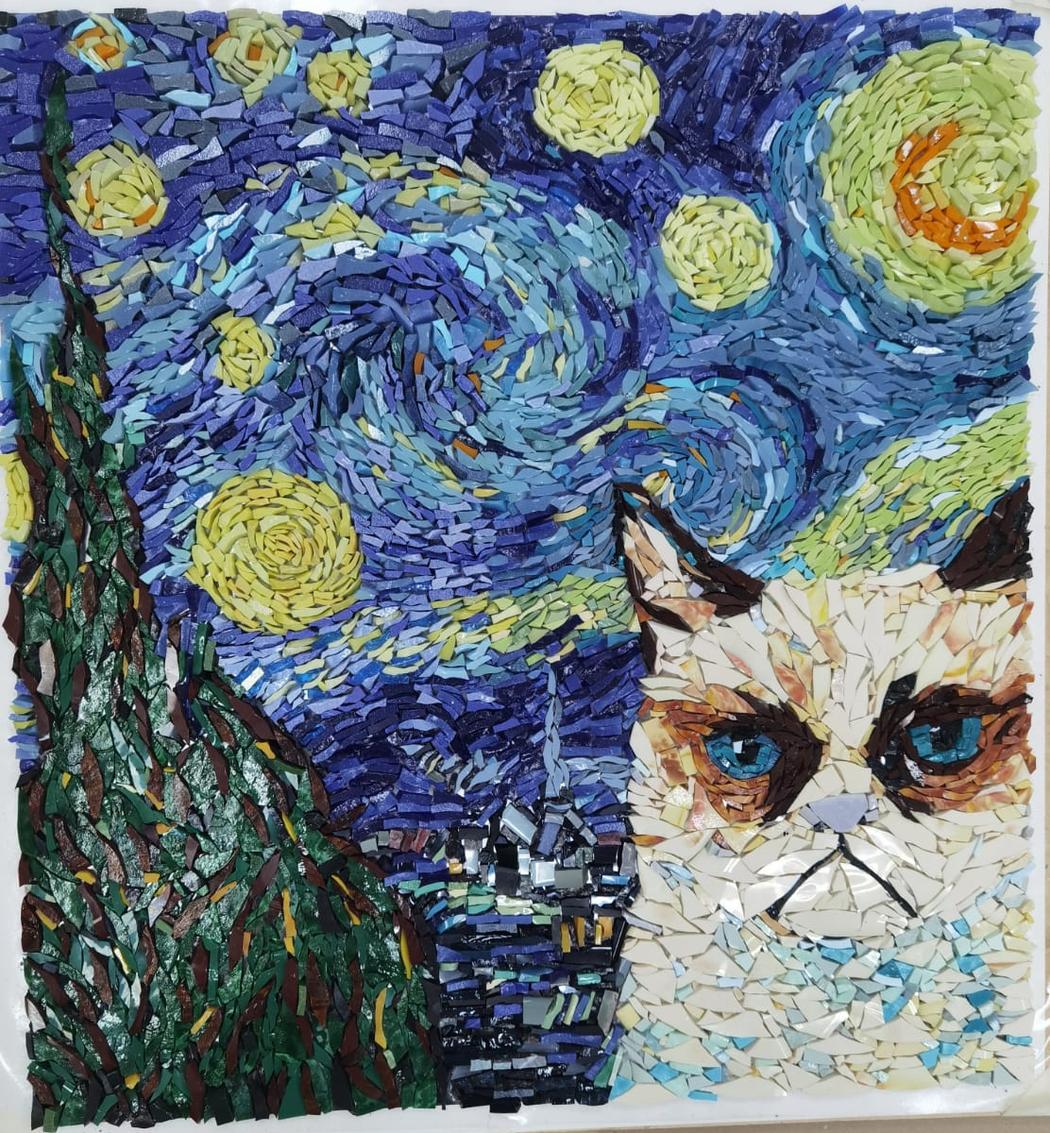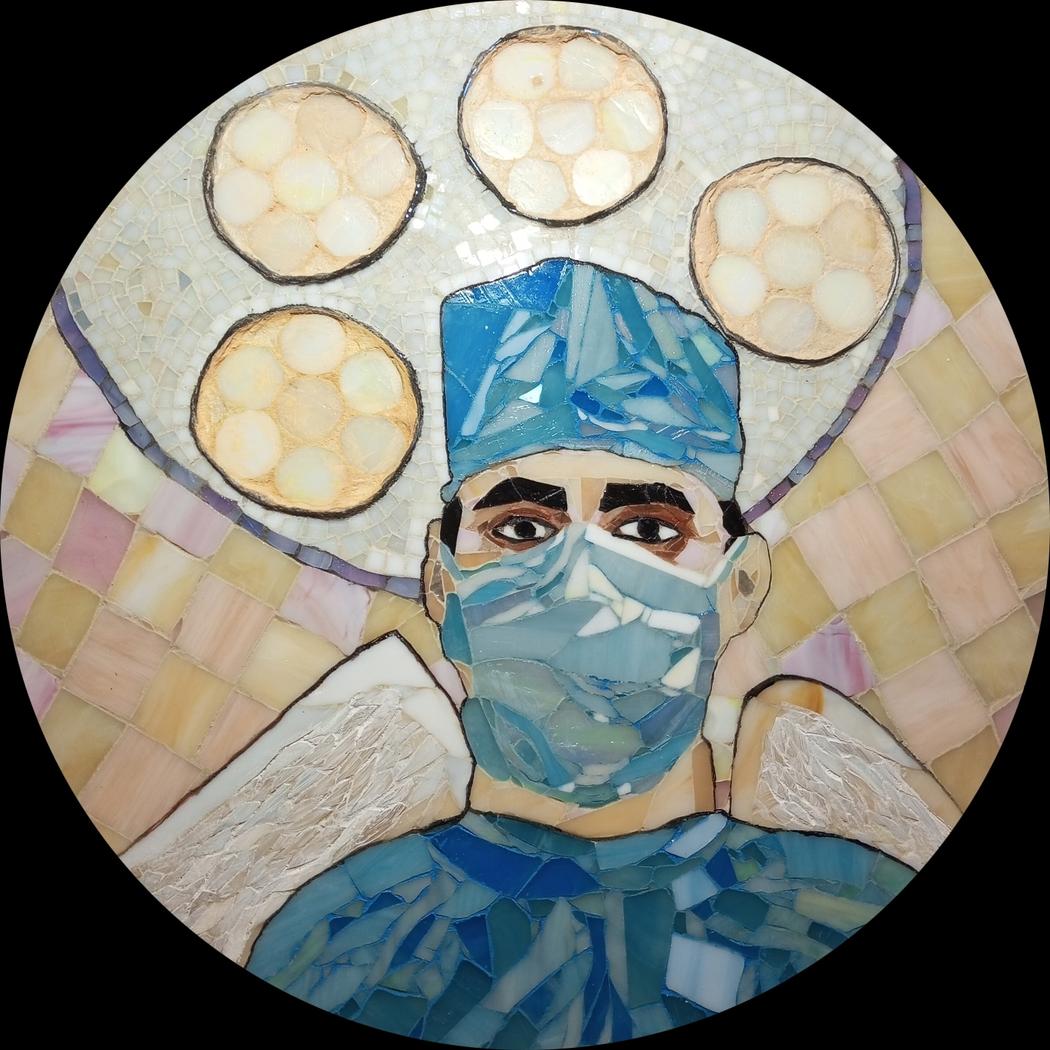Maria Egorova
Describe your art in three words: Eccentric · Vibrant · Conceptual
Your discipline: I strive to capture the multifaceted nature of the contemporary world, where physical reality seamlessly blends with virtual space, while preserving space for authentic human emotions, experiences, and, of course, love!
You describe yourself as an organizer of art projects, a mosaicist, a contemporary artist, and a musician—how do these roles feed each other in your practice?
Yes, indeed, I define myself through many roles. They all emerged organically and helped me at some stage of my life journey; without each of them, I wouldn’t be who I am today. But there is one key connecting link between all these roles — Creativity.
Initially, I was connected with music for most of my life — I started learning to play the piano at the age of five, then the guitar (I could even play the Moonlight Sonata). I also did some drawing. Then there was playing in several bands, first on the guitar, then on the drums — rehearsals, the drive of concerts, a lot of warm memories and emotions.
At some point, the need for artistic self-expression drew my attention to ceramics — I was fascinated by the shapes, the moment when a piece of clay turns into a physical object, and its further refinement to the intended idea with the help of firings and paints. And then, on my way to ceramics, I accidentally turned to mosaics… and stayed there for a long time.
For me, it first became an original way to capture my emotions and ideas, then an attempt to engage in dialogue with the audience within exhibitions, which smoothly evolved into organizing art events. At the same time, I am interested in multidisciplinary events that include not only art exhibitions but also, for example, musical and poetry programs, as well as creative workshops and practices — that’s how all my competencies found organic application, which I am very happy about!

When did mosaic move from “a technique” to your primary language of thinking and meaning-making?
I observed mosaic art for a long time — it’s a very interesting technique, but not as simple as it might seem. It combines both the craft aspect (the method of cutting material, laying it out, and mounting) and the artistic aspect — working with color, texture, combining volumes, etc. At the same time, this is a very, very painstaking occupation — one large work can take about 100 hours of pure time! And it can weigh 15 kilograms or even more!
At first, I just wanted to «give it a try» — there was interest and curiosity. But pretty soon I could no longer see myself in other forms of creativity. If you fall in love with this technique, you can’t stop (every mosaic artist will confirm this).
Every time you start a new work, it seems that you won’t finish it before retirement — but gradually the work progresses, and soon the last tessera is being laid, while a dozen new ideas are already forming in your head!
For me, there is a special magic in mosaic — it’s hard to describe in words. Starting from the fact that the painting begins to live its own life during the creation process and dictates its own conditions (this is how the original concept may change, or certain details may appear or disappear), and ending with the feelings you experience when the work is completed (it’s hard to call it just satisfaction or joy — probably, you put so much energy into the painting that it inevitably acquires a special meaning!)
Interestingly, a certain occupational deformation of consciousness appears — you notice mosaic everywhere or try to imagine how this or that object could be realized in this technique.
 Maria Egorova | Van Cat
Maria Egorova | Van Cat
What did your earliest mosaics look like, and what’s changed most since then?
In my early mosaics, the main task for me was to try and perfect working with various techniques and materials. Of course, the choice of subjects was also important and turned out to be quite symbolic — my first pieces laid the foundation for several series of works and influenced their further style and themes.
Now my works are primarily an invitation to dialogue and reflection. The main focus is on the message and idea, while the artistic design helps to support the concept, to make it interesting for the viewer, and to visualize symbols and narratives. However, I believe that my key works are still ahead! There are many ideas, but since mosaic art is not a quick process, their realization takes time.
How do you balance precision and accident—do you allow chance to shape the composition?
Absolutely! Mosaic art is a rather free and intuitive technique for me — there’s always room for unexpected solutions that emerge during the process. At the same time, you never know how the material will break, but miraculously, each piece finds its rightful place (sometimes the place you’ve designated doesn’t suit it — then it stubbornly jumps out of position)!
Essentially, you have a certain image of the work in your mind, but how it will manifest in practice is always a surprise, even for the artist!
 Maria Egorova | Reboot
Maria Egorova | Reboot
You investigate the border between reality and the subconscious. How do you translate intangible states—dreams, liminality, transformation—into concrete mosaic structure?
Although mosaic is quite a monumental and «rigid» technique, where the artist is bound to the material and its specific characteristics, it nevertheless provides a rather wide scope for artistic expression. This is achieved through 3D effects, the combination of materials, and the use of tesserae in various shapes. All these elements allow emphasizing different aspects of the concept and creating amazing images where even subtle matters find their expression.

How do internet symbols and the cultural code of the 21st century enter your visual vocabulary without becoming mere “references”?
That’s a very interesting question. Let me start with a little story — my first mosaic master class took place in the cozy Favoka studio, where many beautiful works by students were hanging on the walls. However, what surprised me the most was a piece depicting… french fries from McDonald’s in the Roman mosaic technique (one of the oldest techniques). I found it very unusual and amusing.
Later, the teacher gave us a brief overview of the history of mosaic and expressed the idea that nowadays many people try to replicate ancient themes, while in ancient times people used to depict their own lives in mosaics — what they saw, ordinary objects, situations, etc.
In my works, I also want to show modern life. Since people spend a lot of time online, and various memes, emojis, and other digital elements have become part of our cultural code and a special way of connecting people, they occupy a certain part of my creativity. However, I try to weave this symbolism into narratives of the past (for example, you can notice my love for Van Gogh) and, in any case, use them as some kind of reference, trigger, or reason for rethinking and dialogue, rather than just a quote.
What kinds of audience reactions at exhibitions have most surprised or informed you?
It’s fascinating to observe people at exhibitions and their emotions when they interact with art objects. I like that my works evoke various emotions — from surprise at how they were made to smiles and deep contemplation.
As an artist, it’s very valuable for me when a work elicits a response in principle, making the viewer stop and take a closer look. When this happens, it unequivocally means that the artwork has succeeded.

Could you tell us a little about your projects and future plans?
As a mosaic artist and project organizer, my primary focus is on developing themes related to current psychological issues. I am particularly interested in topics such as childhood trauma, depression, stress, anxiety, self-esteem, self-love, and many others.
Together with my colleagues, including psychiatrist Telipov I.N., we are creating projects at the intersection of psychology and art. These projects offer visitors not only the opportunity to engage in dialogue with contemporary art but also to participate in various practices, acquire practical self-help tools, and gain a deeper understanding of themselves and others.
I believe this work is extremely important — it feels like a kind of social mission. In the future, with the support of international colleagues, I hope our projects will expand to the global level.


Leave a Reply